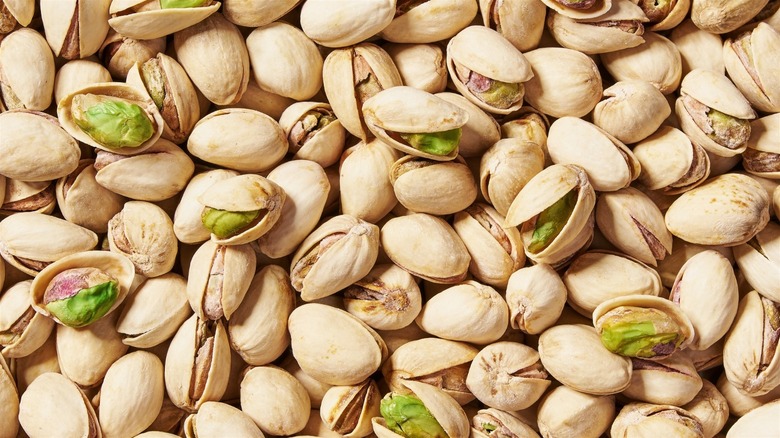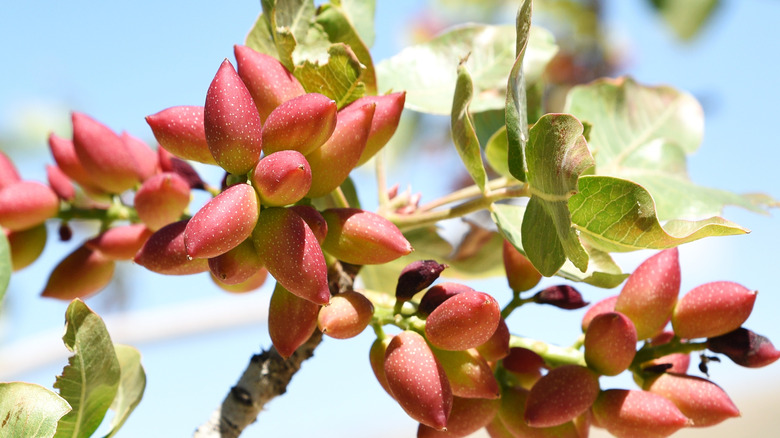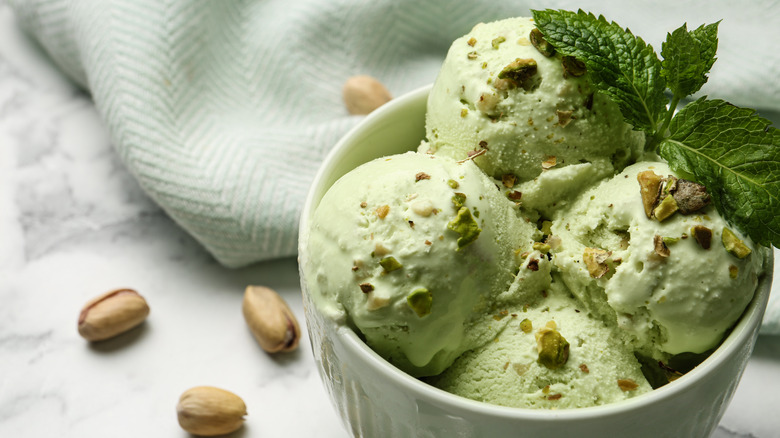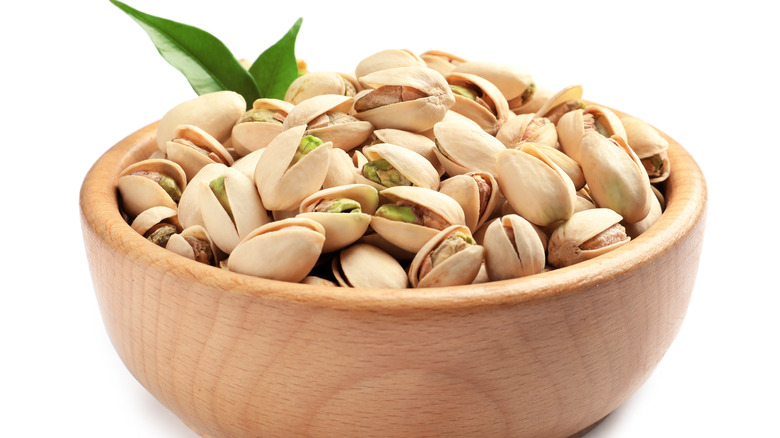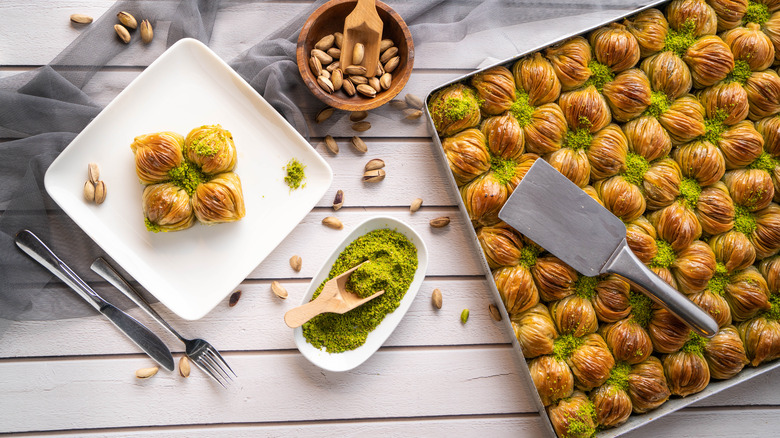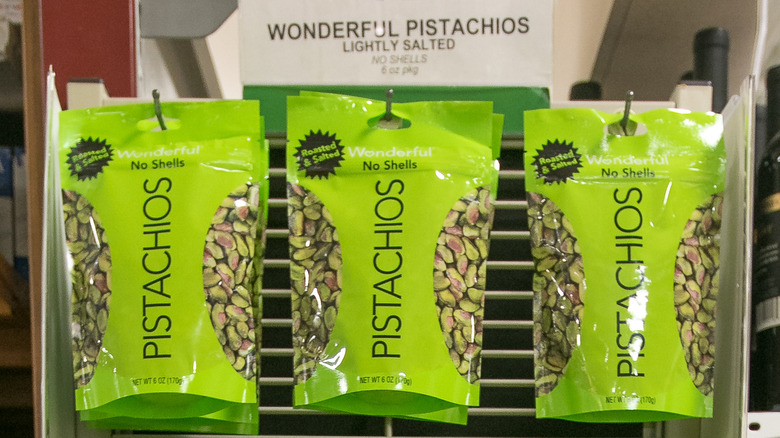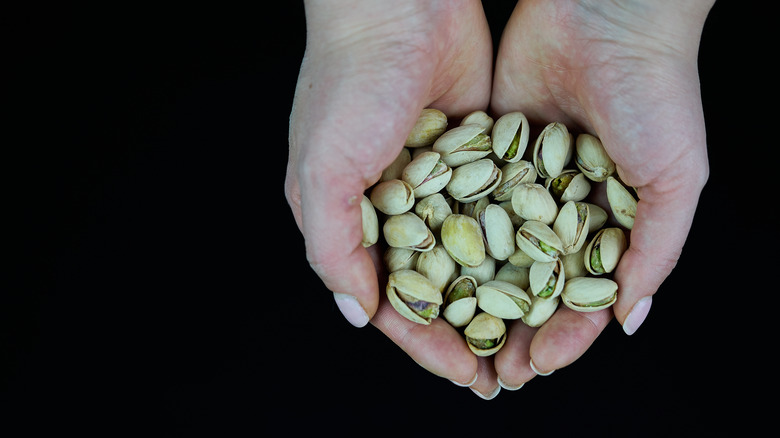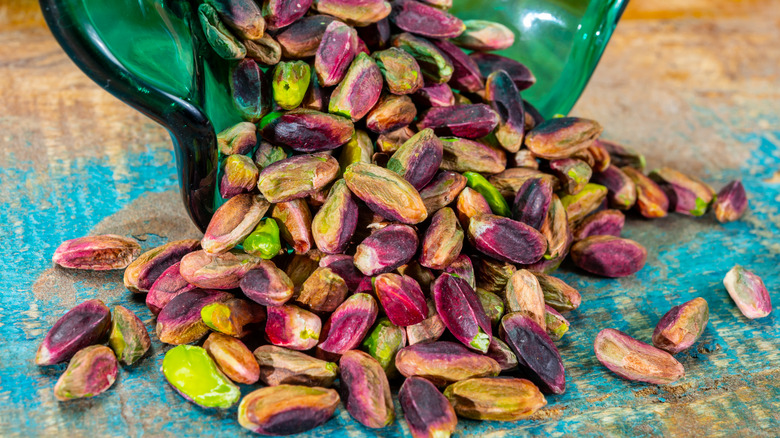What Are Pistachios And How Do You Eat Them?
Sometimes you feel like a nut –- but not just any nut. More and more of us are craving pistachios, a nut that The Produce News reports has overtaken cashews, peanuts, and almonds to become America's favorite, and fastest-growing, snack nut. Today's pistachios, however, may be all but unrecognizable to anyone who hasn't indulged in this product over the past few decades. Back in the 20th century, pistachios were almost always sold in shells, and those shells were a distinctive bright red in color. Part of the joy of eating pistachios, at least for kids, lay in the fact that they stained your fingers and lips bright red. As to the reason behind the red dye, The Spruce Eats speculates that it may have been meant to hide the mottled color of the natural shells.
In the new millennium, however, everyone embraces imperfect produce, not to mention the fact that quicker picking techniques mean less-discolored nuts, so pistachio shells now retain their natural beige color. More recently, though, unshelled pistachios have taken over a larger share of the market, and one producer, Wonderful, has been having great success selling pistachios in flavors including honey-roasted, chili, salt & vinegar, and BBQ.
So what, exactly, is the unshelled truth behind this nut of many colors (and flavors)?
What are pistachios?
The pistachio, or to call it by its formal name, Pistacia vera L. (via Science Direct), is a tree that can grow to be up to 30 feet high. Pistachio "nuts" are actually drupes, although unlike other drupes such as peaches, plums, apricots, and cherries, their edible part is on the inside. Gardeners Yards says that pistachios have been around for 10,000+ years, and they even rate a mention in the Bible's Book of Genesis (via Bible Gateway). According to Brookshire Brothers, though, they only became popular in the United States in the 1930s when they were sold in early vending machines. Those pistachios were imported from Italy, but after World War II pistachio trees were brought stateside. U.S. pistachio production is now centered in three states: California, Arizona, and New Mexico. (Alamogordo, New Mexico is home to Pistachioland, a ranch featuring the World's Largest Pistachio. Sadly, this is a statue and not an actual nut.)
They grow in clusters like grapes, and they helpfully fall off the tree when they ripen. Not only that, but that split in their shells makes them the only nut that doesn't need to be shelled before it's roasted. This split shell has also led to a few cute nicknames: "smiling pistachio" in Iran and "happy nut" in China. Pistachios do have their darker side, though –- they're distant cousins to poison ivy. Less horrifyingly, they're also related to mangoes and cashews.
Pistachios vs 'pistachio' flavor
If you grew up enjoying the taste of bright-green pistachio ice cream, pistachio pudding, and even those classic 1970s treats like Watergate cake and Watergate salad that made ample use of the latter ingredient, you may have wondered why pistachio ice cream and pudding really don't taste too much like pistachio nuts. You aren't the only one asking this question, as witness a Reddit thread, a Quora thread, and a discussion on Cooking Stack Exchange. The reason for this flavor discrepancy may be, as Foodsguy reveals, the fact that while many commercial pistachio ice creams do contain chopped pistachios, they get much of their flavoring from almond extract. The ingredient label of Jell-O pistachio pudding (via Walmart) also lists almonds higher up the list than pistachios.
While many high-end, artisanal ice cream makers these days are producing pistachio ice cream flavored with nothing but the nuts, oftentimes such ice cream leaves pistachio lovers disappointed in their too-subtle flavoring. If you're looking to make a pistachio-flavored dessert but you want that distinctive "green pistachio" ice cream/pudding flavor, some suggest using pistachio paste or pistachio extract. You could even add a teaspoon of almond extract since it's not considered cheating just because you happen to love both types of nuts (and flavors).
What do pistachios taste like?
According to a flavor investigator (yes, that is a real job), the dominant flavor-producing compound present in pistachios is something called alpha-Pinene (via My Food Job Rocks). This lends the nut what they call a "fresh, piney, terpy and resinous [taste] with a slight minty, camphoraceous and spicy nuance."
In layperson's terms, pistachios might instead be described as mild and a little sweet, although as Thrive Cuisine points out, in some of the more aggressively salted varieties of these nuts the seasoning may tend to overwhelm the nuts' natural flavoring. Richard's Pantry describes pistachios as creamy and a little bit earthy, but they do note that pistachios can deteriorate with age. If you bite into a past-its-prime pistachio, you may experience a flavor that is musty, sour, bitter, or equal parts of both, but it's guaranteed to be an experience you won't enjoy. One Redditor notes that there's always one bad nut in a bag which tends to spoil the taste of the next ones you eat. Another commenter on that same thread dubbed this rancid pistachio the "poo poo nut," and pointed out that it may even put you off pistachios forever –- or at least have you resorting to buying the shelled kind where quality control may be more strictly enforced.
How to cook with pistachios
Pistachios, like most types of nuts, are an incredibly versatile ingredient. They can be used to add a little crunch to a salad, or can be chopped fine to make a delicious low carb crust for fish, chicken, or pork. In Italy, the popular lunch meat mortadella often contains chopped pistachios. Pistachios are also delicious in desserts, of course, particularly in traditional Middle Eastern sweets such as halva, baklava, and Turkish delight, as well as in Sicilian cassata cake and cannoli.
Pistachios can also be ground up to make a gluten-free nut flour -– American Pistachio Growers has a recipe on their website for making your own pistachio flour if you like to DIY. You can also use pistachios to make your own pistachio milk (via Whole Foods Market), a delicious alternative to almond milk, or if you want to try something a little more ambitious, vegan food blog Nest and Glow has a recipe for dairy-free pistachio "cheese." If you are a fan of tiki drinks, you might also like to try making your own pistachio orgeat (recipe courtesy of Liquor.com).
Where to buy pistachios
Pistachios can be found in nearly every grocery store, although they may not always be in the same place. They are more likely to be found in the snack foods aisle than over by the baking supplies with the sliced almonds and chopped pecans that are more often employed in cookie-making. As Produce Business reports, however, pistachio displays in the produce section are a powerful marketing tool meant to emphasize how well pistachios go with salads and other fruit and veggie dishes. Pistachios are available shelled or shells-on, salted, unsalted, or flavored. They are usually sold roasted, but you can order raw ones online if you can't find them in-store. If you're purchasing your pistachios directly from the grower, they're most likely to be fresh-picked in late August or September, unless you happen to be in Australia. According to Gardening Know How, Antipodean pistachios are harvested in February.
The one problem with buying pistachios (apart from the aforementioned risk of getting a bad one in the bag), is that if you haven't purchased them since the red shell era, you'll be in for some serious sticker shock. Pistachios do tend to be pretty pricey these days, primarily because they're not the easiest nut to cultivate. In fact, so valuable are pistachios that in California, thieves have been known to heist them by the truckload.
Nutritional information about pistachios
Pistachios are quite the powerhouse, nutritionally speaking. If you are eating a single one-ounce serving, you'll get to consume a full 49 kernels, which American Pistachio Growers claims to be more pieces per ounce than any other type of snack nut. Such a serving contains 160 calories and 13 grams of fat, but only 1.5 grams of the fat is saturated. There's also just eight grams of carbohydrate and 120 milligrams of sodium. This handful of nuts will provide you with 10% of your daily protein, 11% of your necessary fiber, 15% of both thiamine and manganese, 20% of vitamin B, and a full 40% of your recommended daily copper.
Pistachios are also entirely cholesterol-free, and as such are a heart-healthy food. In fact, there is some indication that pistachios, if consumed on a regular basis, may even help to lower your risk of heart disease. Brookshire Brothers also notes that pistachios could possibly assist in preventing macular degeneration due to the high amount of lutein they contain, and the fact that they are chock-full of dietary fiber means they are good for the gut. One study seems to show that pistachios can even help to improve male "reproductive vitality."
Different varieties of pistachios
While all pistachio nuts (and trees) belong to the same species, there are a number of different varieties of the nut that are classified by their place of origin, size, and/or color. When it comes to trees, these are further divided into cultivars, the "girl trees" that produce the nuts, and "pollenizers," the "boy trees" that produce the pollen necessary to make baby nuts (via Sierra Gold Trees).
Spanish website Frutas-Hortalizas ("fruits and vegetables," in English) says that the best-tasting pistachios are the ones grown in Sicily (large and green) and Tunisia (smaller, also green), and that the yellower varieties grown in the Middle East are not quite as flavorful. The Levantine pistachios are nonetheless the dominant varieties worldwide, particularly the Iranian kerman nut which is now grown in California as well. Other nut varieties include the Turkish usun and kermizi, the Syrian batouri, the Tunisian mateur, the Cyprian larnaka, the Greek aegina, and the American Golden Hills, Lost Hills, and Gumdrop.
